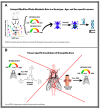Angiotensin-Converting Enzyme Inhibitors and Metabolic Aging: A Drosophila Perspective
- PMID: 41154607
- PMCID: PMC12564483
- DOI: 10.3390/biom15101378
Angiotensin-Converting Enzyme Inhibitors and Metabolic Aging: A Drosophila Perspective
Abstract
Aging is characterized by a progressive decline in physiological function that impairs performance and increases vulnerability to disease and mortality. Delaying this deterioration is key to promoting healthy aging. Age-associated functional decline is closely linked to alterations in intermediary metabolism, including disrupted lipid metabolism and impaired mitochondrial function. Counteracting these metabolic changes, particularly those affecting basal metabolic rate and energy utilization, may be a feasible strategy to extend healthspan. The Renin-Angiotensin System (RAS), which controls blood pressure through Angiotensin II, an octapeptide hormone generated from Angiotensin I by Angiotensin-Converting Enzyme (ACE), has been identified as a potential target for aging therapies. ACE inhibitors, such as the commonly prescribed vasodilator lisinopril, have been shown to exert beneficial effects on healthspan. Disentangling their systemic effects from direct cellular actions on intermediary metabolism is challenging in humans but can be pursued in model organisms. Drosophila melanogaster expresses two ortholog of mammalian ACE, Ance and Acer, which have diverged to acquire different functions. Since fundamental cellular processes are evolutionarily conserved and flies have an open circulatory system, Drosophila provides a versatile model for translational studies on ACE inhibition and aging. Recent studies in Drosophila reveal sex-, age-, and genetic background-specific effects of lisinopril on metabolic rates and aging-related organismal phenotypes. Integrating preclinical findings from Drosophila with clinical studies will be essential to define the therapeutic potential of RAS inhibition in extending lifespan and delaying aging.
Keywords: Drosophila; aging; metabolism; renin-angiotensin system blockade.
Conflict of interest statement
The authors declare no conflicts of interest.
Figures



References
-
- Medawar P.B. An Unsolved Problem of Biology: An Inaugural Lecture Delivered at University College, London, 6 December, 1951. H.K. Lewis and Company; London, UK: 1952. p. 24.
Publication types
MeSH terms
Substances
Grants and funding
LinkOut - more resources
Full Text Sources
Medical
Miscellaneous

